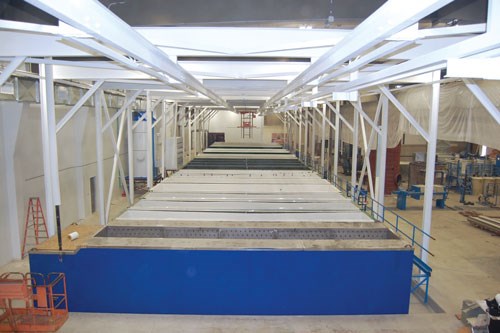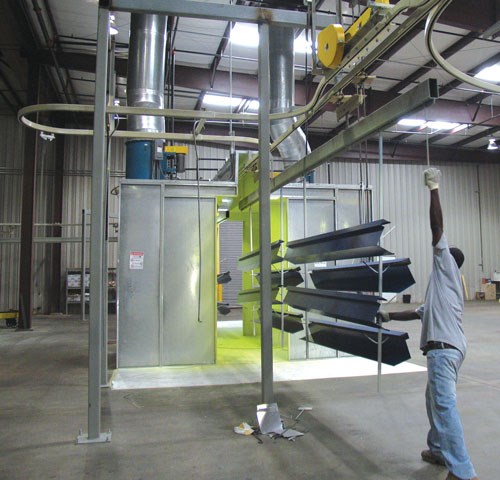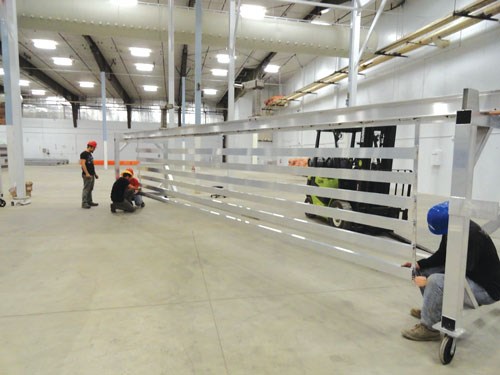Anodizer Heads West to Get to the East
Southern Aluminum Finishing branches out to the Western U.S. and Asia. The new facility will help service its growing list of customers in the Western and Mountain regions of the U.S. and in Canada, as well as to take advantage of overseas orders from the Pacific Rim.
There are not too many office parks and high-rises built along highways in the Southern U.S. that Penn McClatchey can drive past and say his company didn’t have a hand in their construction.
As co-CEOs of SAF Southern Aluminum Finishing Co. in Atlanta, McClatchey and his brother James are seeing continued expansion of the use of aluminum anodized materials in architectural construction here in the U.S., as well as overseas.
“There are major projects all over the country that we are very proud to have had a hand in building,” Penn McClatchey says. “Construction is a cyclical business, and we feel we are at a good place in that cycle right now.”
The feeling is so good at SAF, that the company—founded in 1946 by the McClatcheys’ late father, Marvin—recently expanded to a third anodizing facility, this one in Redding, Calif. The new facility will help service its growing list of customers in the Western and Mountain regions of the U.S. and in Canada, as well as to take advantage of overseas orders from the Pacific Rim. The California operation originally opened in 2007 as a sales office, but its plant operations now include distribution of aluminum extrusions and sheets, metal fabrication and a newly added anodizing service.

Batch Anodizing
The batch anodizing process, which involves racking parts and immersing them in a series of treatment tanks in both acid- and caustic-etched finishes, will produce clear and two-step anodized finishes in bronzes and black hues for parts as long as 28 ft.
“We’re looking forward to the new levels of customer service our SAF-West anodizing line enables,” says James McClatchey, who led the opening of the Redding facility six years ago with five local employees and 20,000 sq ft of space. Now SAF-West operates with 25 employees in 75,000 sq ft, and the company expects to add another 10-20 employees this year.
Even though SAF has already been well-known for half a century throughout the U.S. among subcontractors, architects, design/build contractors, owners and other manufacturers, Penn McClatchey said the company has always wanted to have a production facility in the Western U.S.
“I think it makes us more of a player in the industry to have production capabilities on both sides of the country,” he says. “People in the industry have always known and appreciated our products, but it’s a real commitment on our company’s part to put a plant in California. It sends a message that we are fully capable of serving our customers, and we are looking to play a bigger role in the industry.”
Promising Forecast
According to Kermit Baker, chief economist for the American Institute of Architects (AIA), even though growth in the U.S. economy continues to be somewhat disappointing, nonresidential construction activity is projected to see healthy gains in 2013 with construction spending for buildings rising by 5 percent this year and 7.2 percent in 2014. Construction of commercial facilities—the bread and butter for companies like SAF—is expected to lead the upturn, Baker says, with spending gains of almost 9 percent this year and nearly 11 percent in 2014, led by double-digit gains in hotel construction.

SAF owners John McClatchey Sr., Jim McClatchey, Penn McClatchey and John B. McClatchey Jr..
“Industrial construction spending is projected to nearly match the overall nonresidential building totals this year and next,” Baker says. “While institutional construction activity should lag behind with modest single-digit gains over each of the next two years, healthcare is expected to be the strongest institutional sector.”
The forecast from the AIA’s Consensus Construction Forecast Panel, which is comprised of the nation’s leading construction predictors, are consistent with information derived from the AIA’s Architecture Billings Index (ABI). Baker says the national ABI numbers were mixed in 2011, suggesting an uneven performance for construction in 2012, but they were more uniformly positive in 2012.
“Eight of the 12 months of 2012 showed positive national ABI readings, including the final five months of the year,” he says. “The ABI readings in the fourth quarter of 2012 were the strongest quarter since the downturn began in early 2008, suggesting that construction activity should begin to accelerate significantly in the first half of 2013.”
Great Reputation
That is something SAF is banking on with its new California plant, as well as with its existing facilities in Atlanta and Tennessee, where the company has a great reputation among architectural specifiers, glazing contractors, sign manufacturers, wood and millwork companies, and other commercial construction trades. A survey of glazing contractors published in the October 2010 issue of US Glass magazine listed SAF as the best metal supplier in the country for its ability to meet schedules, the information provided during the building process and its quality of materials.

The SAF-West facility has added batch lines after opening as a sales office.
A lot of that praise may be based on SAF’s “3-Day Out” program, whereby the company will shear, form and ship qualifying orders within three business days or give the customer a 10-percent discount on the entire order. This guarantee has been a major boon for SAF’s sales effort, as builders and contractors love the ability to order material on short notice in order to operate a lean construction site.
SAF also says it is the only supplier in North America that can custom anodize and ship sheet and extrusions for its customers in 24 hours or less. Customers who place orders before 5 p.m. will see them shipped the next business day.
Popular Program
“It’s been a popular program that we’ve offered, but it also has been one that has been driven by market demand,” Penn McClatchey says. “It takes a very disciplined operation to meet these requirements, and our people have done a tremendous job of fulfilling those obligations. The program sends a real message to the people who do business with us.”
That has pretty much been the way SAF has been run since the late 1940s when family patriarch Marvin McClatchey founded Southern Aluminum Finishing and began selling architectural aluminum sheet and extrusions with and without anodized finishes.
By the 1960s, SAF believed that paint finishes had progressed to the point where they could be used on aluminum in commercial building applications, so the company began painting baked enamel on a small scale. By the time fluoropolymer paints were developed, SAF had invested in a complete paint line, which it used for almost 40 years before replacing it in 2006.
At the same time, SAF purchased an awning company and all its fabrication equipment. When air conditioning began to populate more U.S. homes and the awning businesses subsided, SAF turned to making custom aluminum fabrications for its construction customers. And since the company was able to provide the metal plus fabricate and finish it, more builders preferred coming to SAF for their “one-stop” fabrication needs, and its customer base grew. That also led the company to purchase an anodizing line in North Carolina, its first location outside of Georgia.
From there, SAF continued to expand and grow, buying a line of commercial metal roof edge products in the 1990s called Perimeter Systems, while at the same time beginning to coil anodize in its Nashville plant, producing both toll-coated and anodized aluminum coil products.

SAF provides aluminum anodized materials used in architectural construction here in the U.S. as well as overseas..
New Facilities
In 2003 SAF moved its custom fabricating and Perimeter Systems manufacturing to a new, 78,000-sq-ft facility in Winston, about 30 miles from its downtown Atlanta headquarters, where the company increased fabrication capabilities using computerized CNC fabricating equipment. Three years later, SAF added a conveyor run paint line to the fabricating building and closed its older paint plant in Atlanta. Penn McClatchey says the addition of almost 20,000 sq ft of painting facility made SAF one of the few architectural fabricators with its own in-house paint line, and the company was able to roll newly made parts directly to the paint line without the problems of packing cost and freight damage.
In addition to growing and expanding SAF’s physical plants, the McClatcheys have also put in place a proper succession plan for company leadership. John McClatchey retired as president of SAF in late 2012, although he will remain chief financial officer until 2014. His brothers, James and Penn, are sharing the CEO job. James, 63, oversees the sales, IT and finance operations of the company, while Penn, 51, is responsible for operations, engineering and marketing.
“This is an ideal time for a CEO transition,” John McClatchey says. “The company is in very good shape strategically and financially. The management team at SAF is second to none and ready to capitalize on the many opportunities ahead. I have great confidence in Penn and James and their ability to lead SAF to the next level of success. They are surrounded by a very strong group of talented people at all levels of the organization.”
Penn McClatchey says expansion West and the growth in the construction sector are all good news for SAF.
“Years ago this company designed a template on how to operate, how to service our customers and how to innovate,” he says. “We’re following that template and servicing our customers better than ever now.”
For more information on Southern Aluminum Finishing, please call 800-241-7429 or visit saf.com.
Related Content
Corrosion Protection Options for Aluminum
Seeking to understand aluminum corrosion and prevention? Jacob Weingart of Columbia Chemical offers a helpful overview of corrosion protection options for aluminum and its alloys.
Read MoreUnderstanding PEO Coatings
Using high-speed cameras and back side illumination (BSI) sensor technology to analyze plasma electrolytic oxidation.
Read MoreNADCAP Shop Digitizes to Eliminate Paper Trail
Customizable ERP software has transformed a 27-year-old manual metal finishing job shop into a state-of-the-art paperless company with full digital traceability in about 10 months.
Read MoreProducts Finishing Reveals 2024 Qualifying Top Shops
PF reveals the qualifying shops in its annual Top Shops Benchmarking Survey — a program designed to offer shops insights into their overall performance in the industry.
Read MoreRead Next
Flipping the Switch on Anodizing
The idea of using square pulse anodizing is to have a higher average current density for the total process and thereby reduce the process time. When pulsating between two values of current density, a high period and a low period give the aluminum surface time to recover during the low-current-density period.
Read MoreA ‘Clean’ Agenda Offers Unique Presentations in Chicago
The 2024 Parts Cleaning Conference, co-located with the International Manufacturing Technology Show, includes presentations by several speakers who are new to the conference and topics that have not been covered in past editions of this event.
Read MoreDelivering Increased Benefits to Greenhouse Films
Baystar's Borstar technology is helping customers deliver better, more reliable production methods to greenhouse agriculture.
Read More












.jpg;maxWidth=300;quality=90)








